Related Research Articles
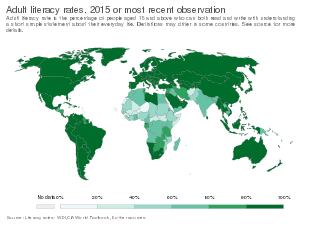
Literacy is the ability to read and write. Some researchers suggest that the study of "literacy" as a concept can be divided into two periods: the period before 1950, when literacy was understood solely as alphabetical literacy ; and the period after 1950, when literacy slowly began to be considered as a wider concept and process, including the social and cultural aspects of reading and writing and functional literacy.
Computer science is the study of the theoretical foundations of information and computation and their implementation and application in computer systems. One well known subject classification system for computer science is the ACM Computing Classification System devised by the Association for Computing Machinery.

Adult education, distinct from child education, is a practice in which adults engage in systematic and sustained self-educating activities in order to gain new forms of knowledge, skills, attitudes, or values. It can mean any form of learning adults engage in beyond traditional schooling, encompassing basic literacy to personal fulfillment as a lifelong learner, and to ensure the fulfillment of an individual.
Bloom's taxonomy is a framework for categorizing educational goals, developed by a committee of educators chaired by Benjamin Bloom in 1956. It was first introduced in the publication Taxonomy of Educational Objectives: The Classification of Educational Goals. The taxonomy divides learning objectives into three broad domains: cognitive (knowledge-based), affective (emotion-based), and psychomotor (action-based), each with a hierarchy of skills and abilities. These domains are used by educators to structure curricula, assessments, and teaching methods to foster different types of learning.

In contemporary education, mathematics education—known in Europe as the didactics or pedagogy of mathematics—is the practice of teaching, learning, and carrying out scholarly research into the transfer of mathematical knowledge.
The concepts of fluid intelligence (gf) and crystallized intelligence (gc) were introduced in 1943 by the psychologist Raymond Cattell. According to Cattell's psychometrically-based theory, general intelligence (g) is subdivided into gf and gc. Fluid intelligence is the ability to solve novel reasoning problems and is correlated with a number of important skills such as comprehension, problem-solving, and learning. Crystallized intelligence, on the other hand, involves the ability to deduce secondary relational abstractions by applying previously learned primary relational abstractions.
In artificial intelligence (AI), commonsense reasoning is a human-like ability to make presumptions about the type and essence of ordinary situations humans encounter every day. These assumptions include judgments about the nature of physical objects, taxonomic properties, and peoples' intentions. A device that exhibits commonsense reasoning might be capable of drawing conclusions that are similar to humans' folk psychology and naive physics.
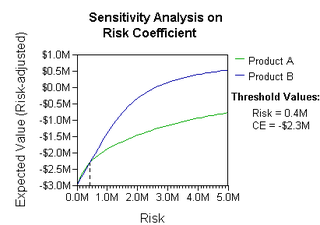
Multiple-criteria decision-making (MCDM) or multiple-criteria decision analysis (MCDA) is a sub-discipline of operations research that explicitly evaluates multiple conflicting criteria in decision making. It is also known as multiple attribute utility theory, multiple attribute value theory, multiple attribute preference theory, and multi-objective decision analysis.
Functional illiteracy consists of reading and writing skills that are inadequate "to manage daily living and employment tasks that require reading skills beyond a basic level". Those who read and write only in a language other than the predominant language of their environs may also be considered functionally illiterate. Functional illiteracy is contrasted with illiteracy in the strict sense, meaning the inability to read or write complete, correctly spelled sentences in any language.
The Key Skills Qualification is a frequently required component of 14-20 education in England, Northern Ireland and Wales. The aim of Key Skills is to encourage learners to develop and demonstrate their skills as well as learn how to select and apply skills in ways that are appropriate to their particular context.
The Iowa Tests of Educational Development (ITED) are a set of standardized tests given annually to high school students in many schools in the United States, covering Grades 9 to 12. The tests were created by the University of Iowa's College of Education in 1942, as part of a program to develop a series of nationally accepted standardized achievement tests. The primary goal of the ITED is to provide information to assist educators in improving teaching.

The most recent comprehensive data on adult literacy in the United States come from the Program for the International Assessment of Adult Competencies (PIAAC) study conducted in stages from 2012 to 2017 by the National Center for Education Statistics (NCES). English literacy test results from 2014 suggest that 21% of U.S. adults ages 16 to 65 score at or below PIAAC literacy level 1, meaning they have difficulty "[completing] tasks that require comparing and contrasting information, paraphrasing, or making low-level inferences." Included in that 21% is the 4.2% of respondents who were unable to be assessed due to language barriers, cognitive disability, or physical disability. A 2020 study by the Gallup analysis company funded by the Barbara Bush Foundation for Family Literacy estimated that getting all U.S. adults to at least PIAAC literacy level 3 proficiency would raise American's incomes by $2.2 trillion.
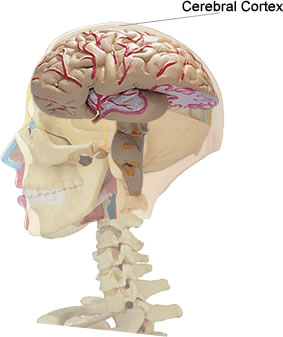
Analytical skill is the ability to deconstruct information into smaller categories in order to draw conclusions. Analytical skill consists of categories that include logical reasoning, critical thinking, communication, research, data analysis and creativity. Analytical skill is taught in contemporary education with the intention of fostering the appropriate practices for future professions. The professions that adopt analytical skill include educational institutions, public institutions, community organisations and industry.

Reading is the process of taking in the sense or meaning of symbols, often specifically those of a written language, by means of sight or touch.
Neo-Piagetian theories of cognitive development criticize and build upon Jean Piaget's theory of cognitive development.
In mathematics education, a representation is a way of encoding an idea or a relationship, and can be both internal and external. Thus multiple representations are ways to symbolize, to describe and to refer to the same mathematical entity. They are used to understand, to develop, and to communicate different mathematical features of the same object or operation, as well as connections between different properties. Multiple representations include graphs and diagrams, tables and grids, formulas, symbols, words, gestures, software code, videos, concrete models, physical and virtual manipulatives, pictures, and sounds. Representations are thinking tools for doing mathematics.
Graph literacy is the ability to understand information that presented graphically, which are including general knowledge about how to extract information and make inferences from different graphical formats. Although related, graph literacy is distinct from other forms of literacy in the sense that it relates more specifically to one's ability to obtain meaning from information presented graphically. It can include the storage of mental representations in long-term memory, knowledge about the properties of different types of formats, and procedures to interpret them. However, similar to other types of literacy, higher graph literacy is associated with higher education levels and suggests that developing the skills required to interpret graphical information requires knowledge that is acquired through formal education and experience.
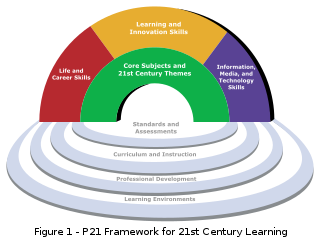
21st century skills comprise skills, abilities, and learning dispositions identified as requirements for success in 21st century society and workplaces by educators, business leaders, academics, and governmental agencies. This is part of an international movement focusing on the skills required for students to prepare for workplace success in a rapidly changing, digital society. Many of these skills are associated with deeper learning, which is based on mastering skills such as analytic reasoning, complex problem solving, and teamwork, which differ from traditional academic skills as these are not content knowledge-based.
This glossary of artificial intelligence is a list of definitions of terms and concepts relevant to the study of artificial intelligence (AI), its subdisciplines, and related fields. Related glossaries include Glossary of computer science, Glossary of robotics, and Glossary of machine vision.
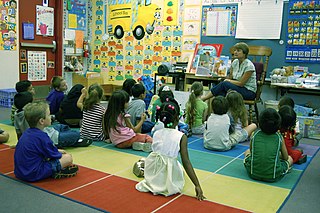
Kindergarten readiness refers to the developmental domains that contribute to children's ability to adapt to the kindergarten classroom, which is often a new and unfamiliar environment. There is no single agreed upon definition of Kindergarten readiness. The domains often included in the definition comprise: academic skills, social-emotional development, and physical development. In addition to these competencies, the child's environment and opportunities for learning should also be considered. This includes the child's home environment and their interactions with teachers and peers.
References
- ↑ OECD (2013). OECD Skills Outlook 2013.
- ↑ Thorn, William (2009). "International Adult Literacy and Basic Skills Surveys in the OECD Region". OECD Education Working Papers. 26. OECD Publishing. Retrieved 2013-04-26.
- ↑ "Survey of Adult Skills (PIAAC)". OECD.
- 1 2 "Adult Literacy and Lifeskills (ALL) - Overview".
- 1 2 Beatrice Rammstedt; Daniela Ackermann; Susanne Helmschrott; Anja Klaukien; Débora B. Maehler; Silke Martin; Natascha Massing; Anouk Zabal (2013). PIAAC 2012: Overview of the Main Results (PDF).
- 1 2 3 4 5 6 7 8 9 10 11 12 13 14 15 16 "Highlights from the U.S. PIAAC Survey of Incarcerated Adults: Their Skills, Work Experience, Education, and Training Program for the International Assessment of Adult Competencies: 2014" (PDF). US Department of Education. November 2016. Retrieved 5 August 2021.
 This article incorporates text from this source, which is in the public domain .
This article incorporates text from this source, which is in the public domain . - ↑ "PIAAC - Organisation for Economic Co-operation and Development". www.oecd.org. Archived from the original on 2013-08-09.
- ↑ OECD 2013
- 1 2 Schmidt, Emily (16 March 2022). "Reading the Numbers: 130 Million American Adults Have Low Literacy Skills, But Funding Differs Drastically By State". apmresearchlab.org. American Public Media. Retrieved 12 August 2022.
- ↑ Rothwell, Ph.D., Jonathan (8 September 2020). "Assessing the Economic Gains of Eradicating Illiteracy Nationally and Regionally in the United States" (PDF). barbarabush.org. Gallup. Retrieved 4 August 2022.